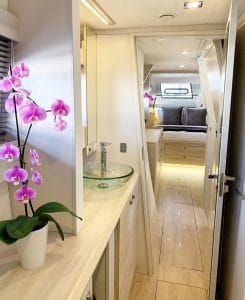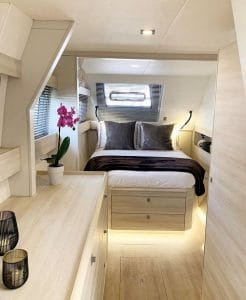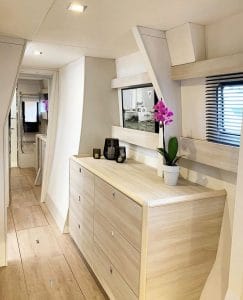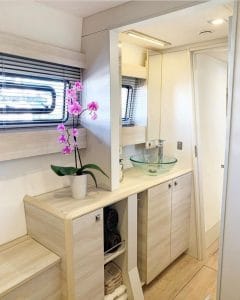Written by: Zuzana Prochazka
https://www.yachtworld.com/research/catana-53-review/
There’s no better description for a boat than as a set of tradeoffs. Comfort usually comes at the expense of performance, complexity battles ease-of-management, and a lengthy features list moves opposite the budget. A perfect boat doesn’t exist, but if you’re searching for a proven bluewater multihull that can be sailed by two, has all the comforts of a posh home but is wicked fast, and won’t beat up your wallet, you must put the Catana 53 on your shortlist.
I’ve spent time on Catanas before, namely several 47s, and I like them because I trust them. They’re fast, strong and evenly tempered in a blow, which is more than you can say for other ultra-high performance multis that tend to be difficult thoroughbreds. The two drawbacks to Catanas have always been sparse interior volume, especially in the hulls, and the helms being out on the hulls from which visibility forward is challenging. Enter the Catana 53 that is as comfortable as she is fast. Despite the helm positions remaining outside, this design dials in visibility better than any of her siblings have to date and her high freeboard has allowed the cabins to enjoy increased volume.
The Catana 53 I sailed was managed by a couple and was brought over the Atlantic on her own bottom by them and one other crewmember. Not only did the boat not look any worse for wear, neither did they. There was even a video of a rock-steady wine glass as the boat sailed at 22 knots. Some of this has to do with the high bridge deck that now starts farther aft to preclude pounding, which cats are known for when going to weather. The exterior lines are appealing and practical with reverse bows, curved dagger-boards and wide, flat, uncluttered decks dotted sparsely with flush hatches. The new 53 shares the boxy, angular design of the 62 and 70-foot models and the 42 and 47-footers are set to acquire this aesthetic in the future.
The French builder uses an infusion layup with carbon reinforcement to maximize performance and load carrying capabilities. It seems as though Catana took nearly a ton of weight out of the older design with the use of carbon around the chainplates, the mast base and in the coachroof. According to the owners, at nearly 31,000 pounds, the boat loads up in a squall and moves forward like a train – steady and stiff rather than squirmy and overpowered. I have been know to take other Catanas out in a stiff breeze, put in a reef and trust the boat to take care of herself from there.
Interior Appeal
The Catana 53 is available with three or four cabins and a fluid head arrangement. Our test boat had the owner’s suite in the starboard hull with a unique shower layout that required no curtain nor door. Because Catana is a semi-custom builder, opportunities for personalization are many and these owners reconfigured the master head to suit their needs and tastes.
The saloon above is very spacious with the nav desk in the forward port corner and at least half the space dedicated to a galley not seen in most apartments. The four Vitrifrigo refrigeration drawers, bottle cooler and acres of countertop space would give galley envy to many a chef.
This model is powered by 75 HP Turbo Volvo Penta diesels.




Performance
Unfortunately, we didn’t get the gale I hoped for to sail this tough cat. In fact, the wind was comically light so we tested her in a different way. Multihulls aren’t fond of going to weather and pointing high is challenging for them, especially in light winds; however, we sailed at 4 knots in 7 knots of true wind speed at 40 degrees. Yes, it was on the flat water of the Chesapeake, but 40 degrees apparent wind angle in such light conditions was impressive. We cracked off to 60 degrees apparent wind angle and registered 5 knots of boat speed with nearly 1,100 square feet of sail area between the main and self-tacking jib. The owners commented that they had crossed the ocean with 200+ mile days, averaging 9 knots. The real test came when we tacked back-to-back with barely any way on and made it through the eye of the wind with no need to backwind the sails or start an engine.
This was an ideal time to review the two things that have been the design’s Achilles heel–visibility and exposure for the driver both due to the placement of the helms. First, from either wheel, the sight-lines are excellent aft and good to the bow of whichever hull you happen to be driving from. The opposite corner is obscured by the coachroof but for the first time, the idea of looking through the saloon windows actually worked. It’s not good enough for docking bow-in but most cats dock stern-in anyway. Also, the hatches in the Bimini are positioned so you can see the mainsail from the cockpit without needing to step on the side decks.
Second, most people on a passage drive from the inside with the autopilot. Not only is there an autopilot control at the nav desk, there’s also excellent visibility through the saloon windows that have been made larger on this model. Furthermore, the cockpit, saloon and helms are on the same level so if something does need to be dealt with quickly, a few steps put you at the wheel and in control in a second without the need to climb up to a flybridge helm. Six Harken winches on the sides of the cockpit control all the sheets and the davits and once you learn which one does what, it’s a setup that allows this large cat to be singlehanded.
Under power, the Catana 53 is a joy. Engine throttles for the 75 HP Turbo Volvo Penta diesels are at both helms so no matter which way you need to dock in a tight space, you have control of the vessel. At wide-open throttle and 3000 rpm, we motored at 9.4 knots. A more economical cruising speed would be 2200 rpm and 7.4 knots. For long passages, you can always motor at six knots on one engine and save fuel as well as wear and tear on the motors. According to the owners, about the only drawback to these engines is that at 1600 rpm the turbo kicks off affecting the 50,000 BTU, six-zone air conditioning system. But then, that’s what the 11kW Cummins genset is for.
The details are what make living aboard either fabulous or a hassle and with experienced owners in all corners of the globe, Catana has benefitted from valuable feedback. The use of space is excellent with no cubby left underutilized and even the stowage under the master berth is finished on both sides. There’s great access to everything from systems to cubbies and there’s an air cushion between the headliner and the composite structure so there’s no condensation. The design is also attractive, looking like she’s ready for battle even at anchor. The as-tested price is $1.4 million with just about all the bells and whistles and although that’s higher than many production cats, it’s less than half the price of all-carbon competitors that sail comparably but arguably with more complex systems.
For long-range performance cruising you can’t beat a Catana. For a cat with a stylish design, ease-of-use and the price, you can’t beat the Catana 53. About the only thing missing is the hydraulic swim platform to carry the tender. These teak beaches have been popping up on other cat designs in this class. It would add weight and maybe that’s why it’s not offered, but having played on one, that’s a tradeoff I’d certainly make.
I’ve been searching for the perfect cruising cat for years and although I know very well that there’s no perfect boat, I’d say this one’s as close as any I’ve seen.
Zuzana Prochazka